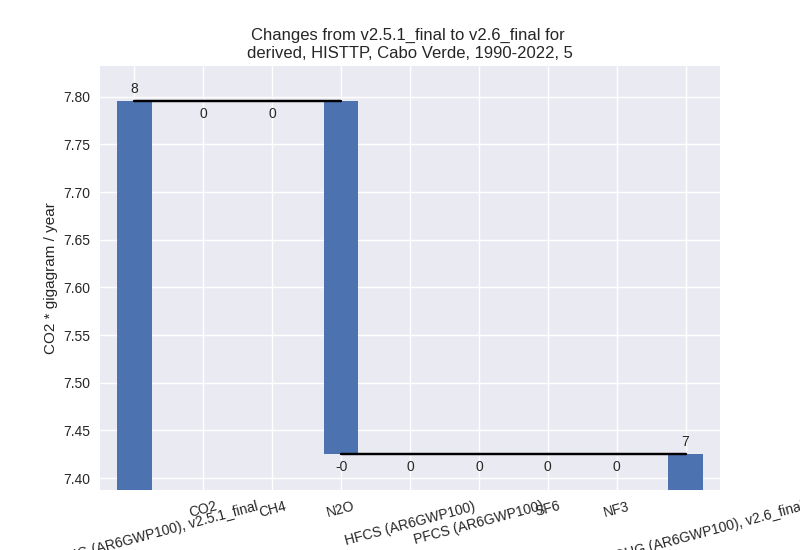Changes in PRIMAP-hist v2.6_final compared to v2.5.1_final for Cabo Verde
2024-09-24
Johannes Gütschow
Change analysis for Cabo Verde for PRIMAP-hist v2.6_final compared to v2.5.1_final
Overview over emissions by sector and gas
The following figures show the aggregate national total emissions excluding LULUCF AR6GWP100 for the country reported priority scenario. The dotted linesshow the v2.5.1_final data.
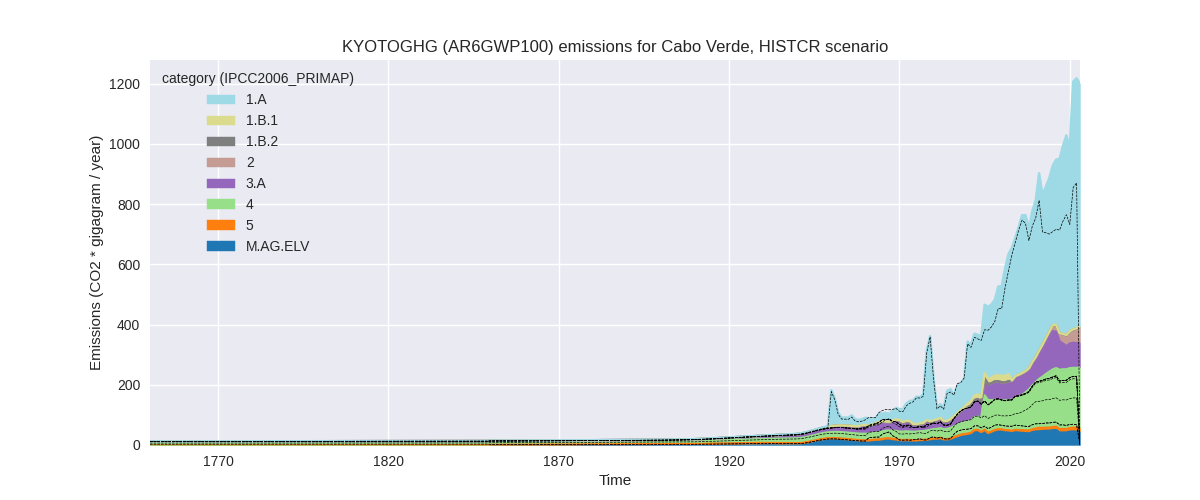
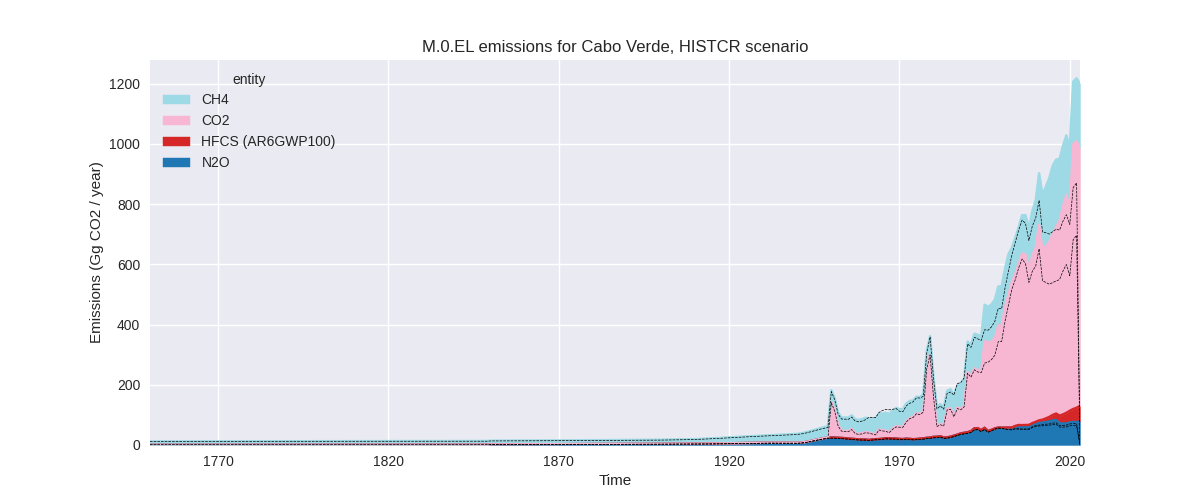
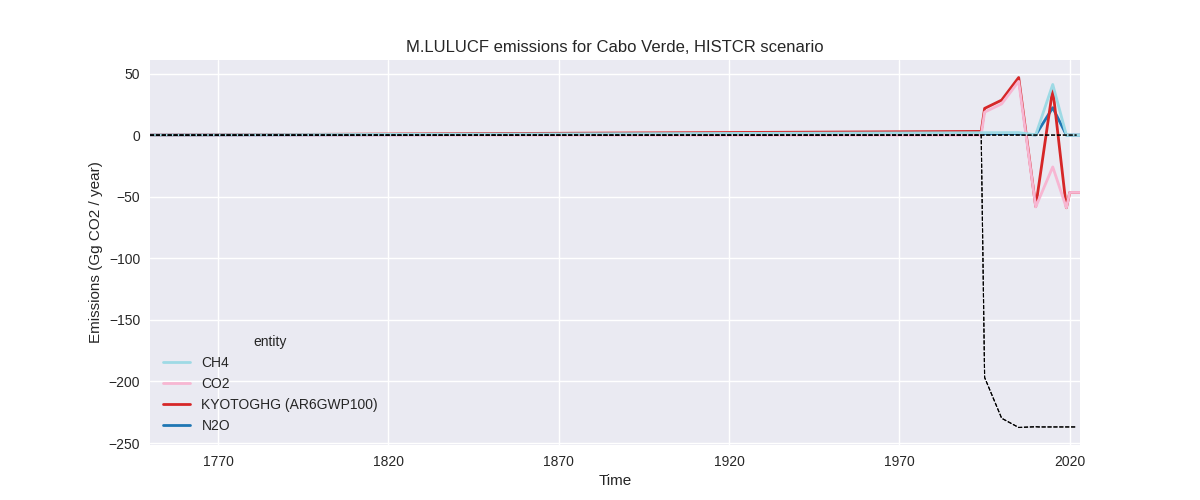
The following figures show the aggregate national total emissions excluding LULUCF AR6GWP100 for the third party priority scenario. The dotted linesshow the v2.5.1_final data.
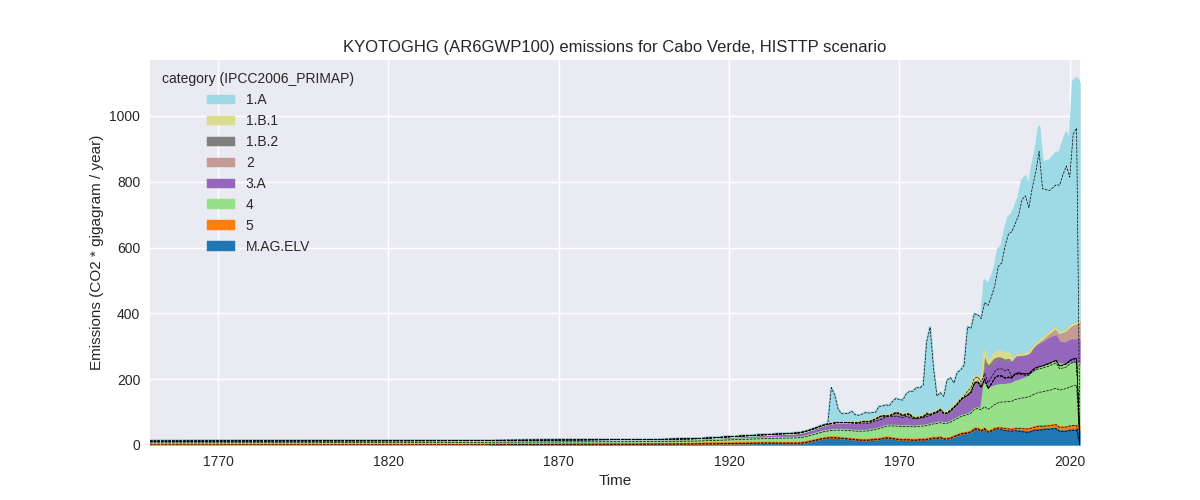
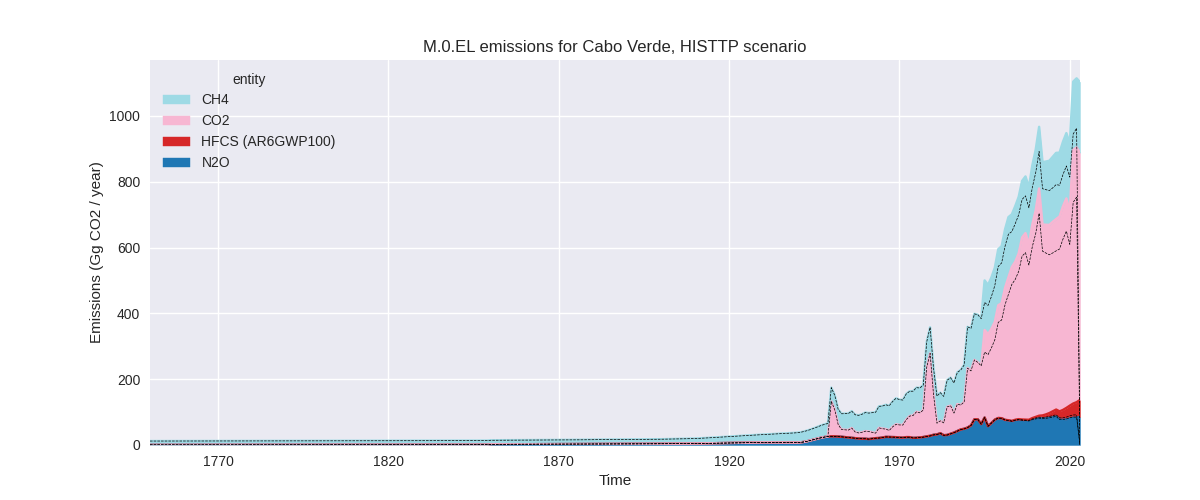
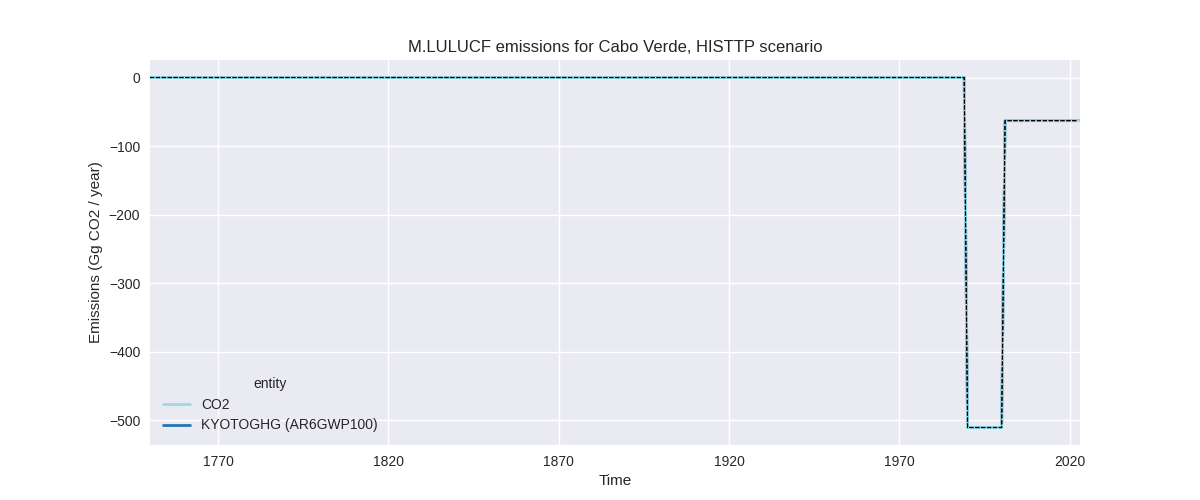
Overview over changes
In the country reported priority scenario we have the following changes for aggregate Kyoto GHG and national total emissions excluding LULUCF (M.0.EL):
- Emissions in 2022 have changed by 39.9%% (347.19 Gg CO2 / year)
- Emissions in 1990-2022 have changed by 18.0%% (108.69 Gg CO2 / year)
In the third party priority scenario we have the following changes for aggregate Kyoto GHG and national total emissions excluding LULUCF (M.0.EL):
- Emissions in 2022 have changed by 15.7%% (151.58 Gg CO2 / year)
- Emissions in 1990-2022 have changed by 9.9%% (65.34 Gg CO2 / year)
Most important changes per scenario and time frame
In the country reported priority scenario the following sector-gas combinations have the highest absolute impact on national total KyotoGHG (AR6GWP100) emissions in 2022 (top 5):
- 1: 1.A, CO2 with 193.95 Gg CO2 / year (31.1%)
- 2: 4, CO2 with 66.03 Gg CO2 / year (15133.1%)
- 3: 4, CH4 with 43.16 Gg CO2 / year (53.1%)
- 4: 2, HFCS (AR6GWP100) with 40.58 Gg CO2 / year (594.7%)
- 5: M.AG.ELV, CH4 with -14.90 Gg CO2 / year (-87.2%)
In the country reported priority scenario the following sector-gas combinations have the highest absolute impact on national total KyotoGHG (AR6GWP100) emissions in 1990-2022 (top 5):
- 1: 4, CO2 with 54.89 Gg CO2 / year (23824.3%)
- 2: 4, CH4 with 20.16 Gg CO2 / year (40.9%)
- 3: 1.A, CO2 with 20.09 Gg CO2 / year (4.9%)
- 4: M.AG.ELV, CH4 with -17.18 Gg CO2 / year (-87.8%)
- 5: 3.A, CH4 with 12.34 Gg CO2 / year (22.4%)
In the third party priority scenario the following sector-gas combinations have the highest absolute impact on national total KyotoGHG (AR6GWP100) emissions in 2022 (top 5):
- 1: 4, CO2 with 66.03 Gg CO2 / year (15133.1%)
- 2: 1.A, CO2 with 46.91 Gg CO2 / year (7.1%)
- 3: 2, HFCS (AR6GWP100) with 40.58 Gg CO2 / year (594.7%)
- 4: 5, N2O with -1.99 Gg CO2 / year (-13.0%)
- 5: 4, CH4 with 0.35 Gg CO2 / year (0.3%)
In the third party priority scenario the following sector-gas combinations have the highest absolute impact on national total KyotoGHG (AR6GWP100) emissions in 1990-2022 (top 5):
- 1: 4, CO2 with 54.89 Gg CO2 / year (23824.3%)
- 2: 2, HFCS (AR6GWP100) with 7.90 Gg CO2 / year (360.8%)
- 3: 1.A, CO2 with 3.12 Gg CO2 / year (0.8%)
- 4: 5, N2O with -0.37 Gg CO2 / year (-4.7%)
- 5: 4, CH4 with -0.12 Gg CO2 / year (-0.1%)
Notes on data changes
Here we list notes explaining important emissions changes for the country. ’' means that the following text only applies to the TP time series, while means that it only applies to the CR scenario. Otherwise the note applies to both scenarios.
- We have included data from BUR1 leading to changes for many gases and sectors in the CR time-series.
- For Energy CO2 emissions are lower between 2000 and 2010 but higher afterwards as BUR1 data is higher than older country reported data extended with growth rates from CDIAC and EI.
- Waste CO2 emissions are two orders of magnitude higher in BUR1 than in earlier reports. the high CO2 emissions probably come from open burning of waste (see page 35 in BUR1). As there is no other input data for waste CO2, this affects the TP time-series equally. Waste CH4 emissions are higher as well.
- HFCS: new values continue to increase steeper than estimated in PRIMAP-hist v2.5.1
- Waste N2O data now follows EDGAR for the TP and CR time-series as there is no data in BUR1
Changes by sector and gas
For each scenario and time frame the changes are displayed for all individual sectors and all individual gases. In the sector plot we use aggregate Kyoto GHGs in AR6GWP100. In the gas plot we usenational total emissions without LULUCF. ## country reported scenario
2022
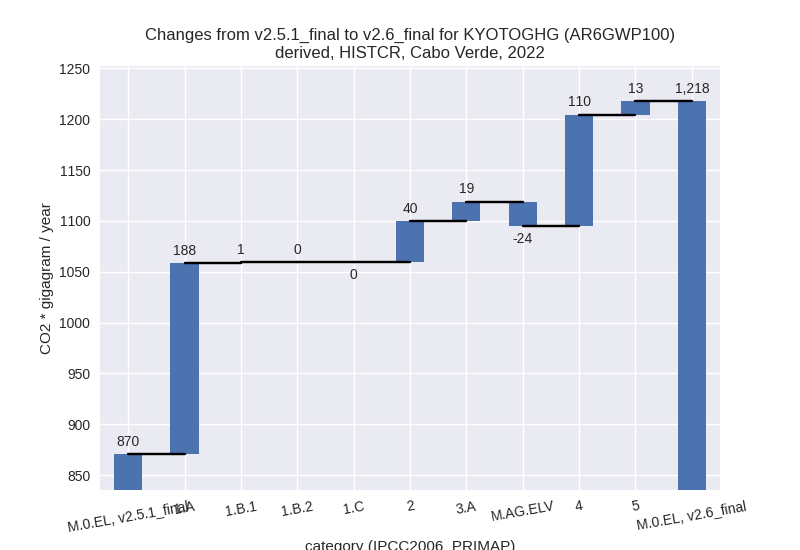
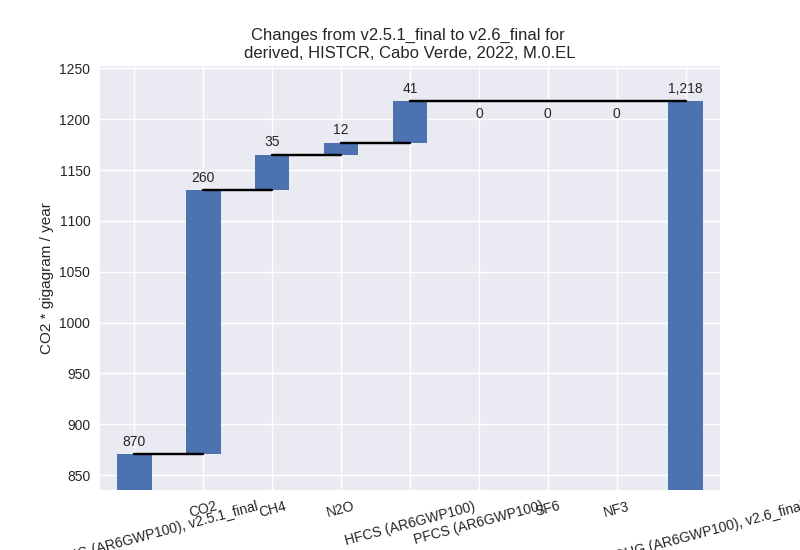
1990-2022
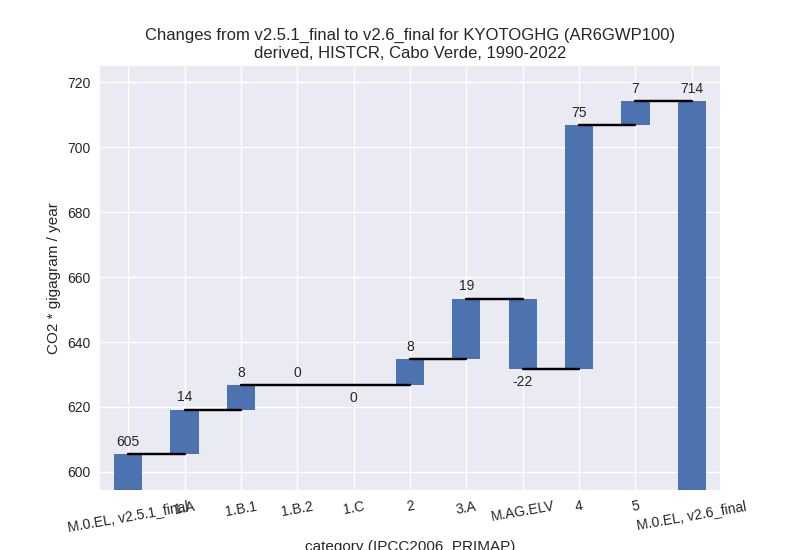
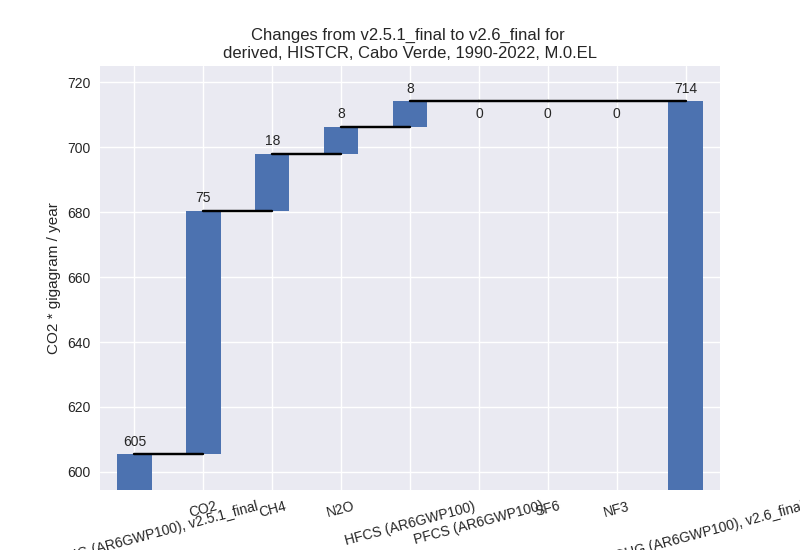
third party scenario
2022
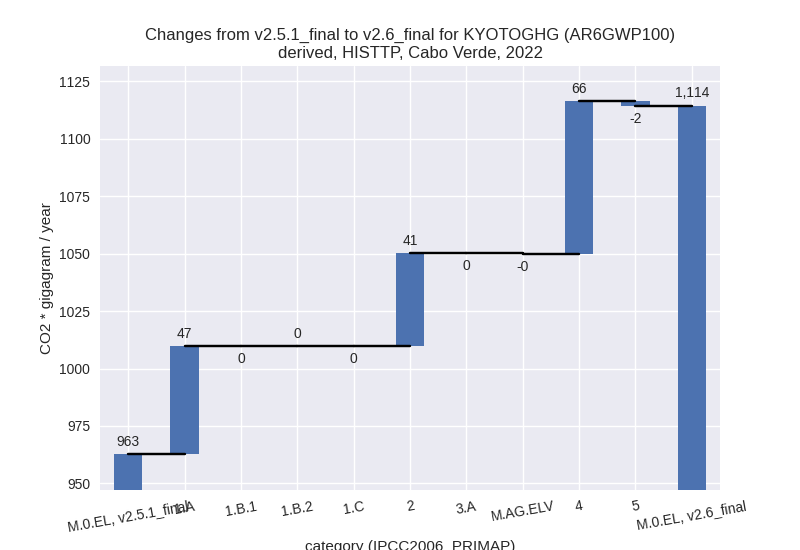
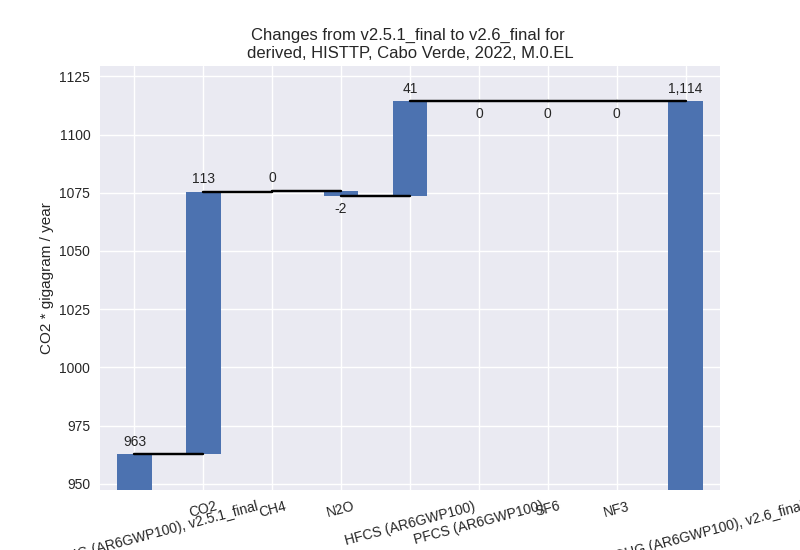
1990-2022
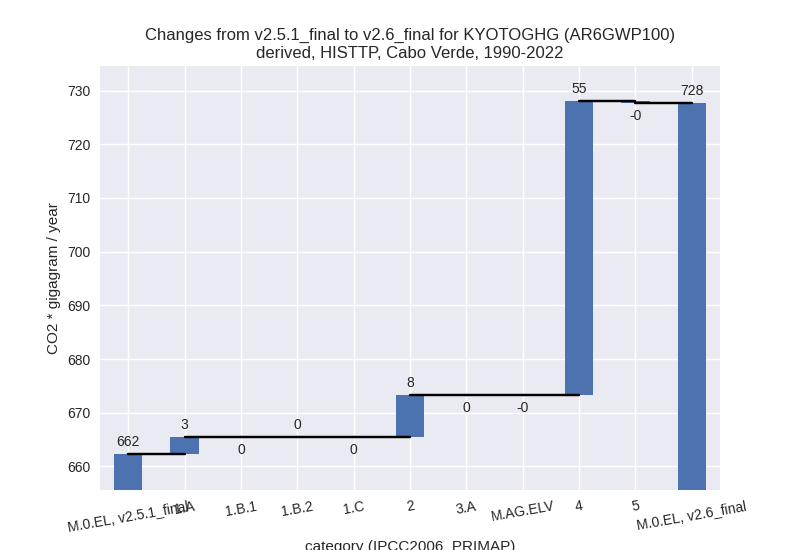

Detailed changes for the scenarios:
country reported scenario (HISTCR):
Most important changes per time frame
For 2022 the following sector-gas combinations have the highest absolute impact on national total KyotoGHG (AR6GWP100) emissions in 2022 (top 5):
- 1: 1.A, CO2 with 193.95 Gg CO2 / year (31.1%)
- 2: 4, CO2 with 66.03 Gg CO2 / year (15133.1%)
- 3: 4, CH4 with 43.16 Gg CO2 / year (53.1%)
- 4: 2, HFCS (AR6GWP100) with 40.58 Gg CO2 / year (594.7%)
- 5: M.AG.ELV, CH4 with -14.90 Gg CO2 / year (-87.2%)
For 1990-2022 the following sector-gas combinations have the highest absolute impact on national total KyotoGHG (AR6GWP100) emissions in 1990-2022 (top 5):
- 1: 4, CO2 with 54.89 Gg CO2 / year (23824.3%)
- 2: 4, CH4 with 20.16 Gg CO2 / year (40.9%)
- 3: 1.A, CO2 with 20.09 Gg CO2 / year (4.9%)
- 4: M.AG.ELV, CH4 with -17.18 Gg CO2 / year (-87.8%)
- 5: 3.A, CH4 with 12.34 Gg CO2 / year (22.4%)
Changes in the main sectors for aggregate KyotoGHG (AR6GWP100) are
- 1: Total sectoral emissions in 2022 are 831.13 Gg
CO2 / year which is 68.3% of M.0.EL emissions. 2022 Emissions have
changed by 29.4% (188.77 Gg CO2 /
year). 1990-2022 Emissions have changed by 5.0% (21.25 Gg CO2 / year). For 2022 the
changes per gas
are:
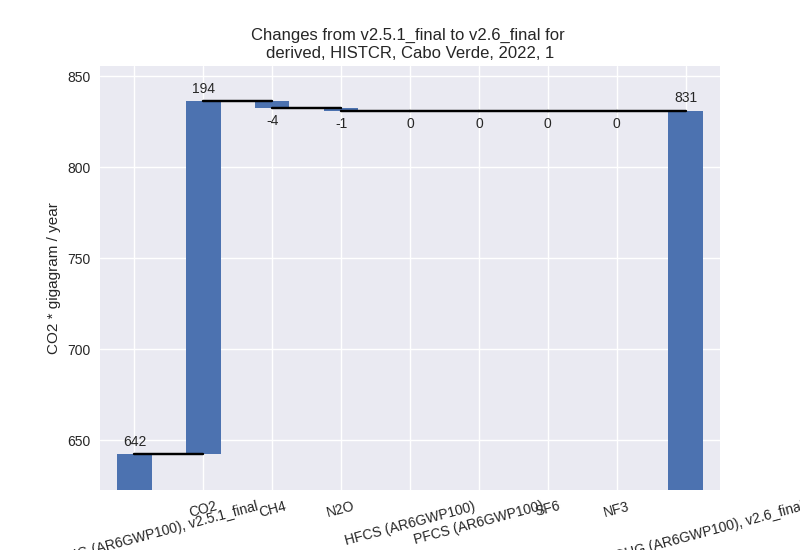
For 1990-2022 the changes per gas are: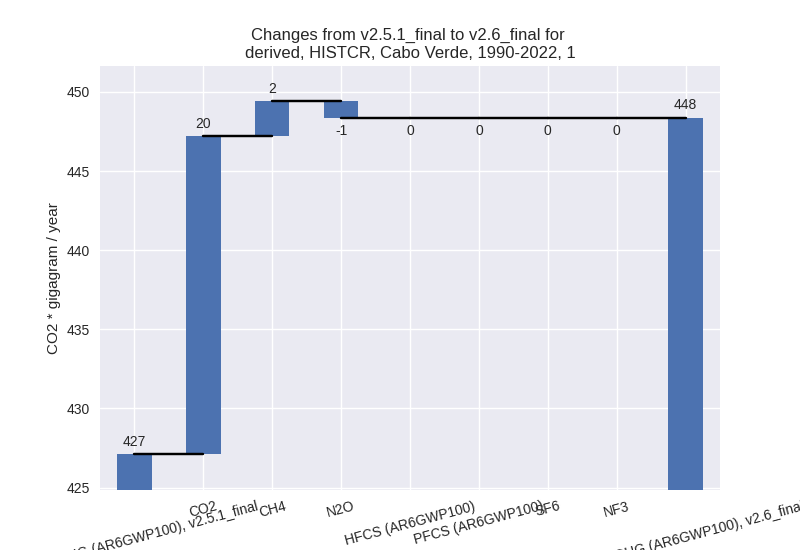
The changes come from the following subsectors:- 1.A: Total sectoral emissions in 2022 are 830.14 Gg
CO2 / year which is 99.9% of category 1 emissions. 2022 Emissions have
changed by 29.2% (187.79 Gg CO2 /
year). 1990-2022 Emissions have changed by 3.2% (13.64 Gg CO2 / year). For 2022 the
changes per gas
are:

For 1990-2022 the changes per gas are: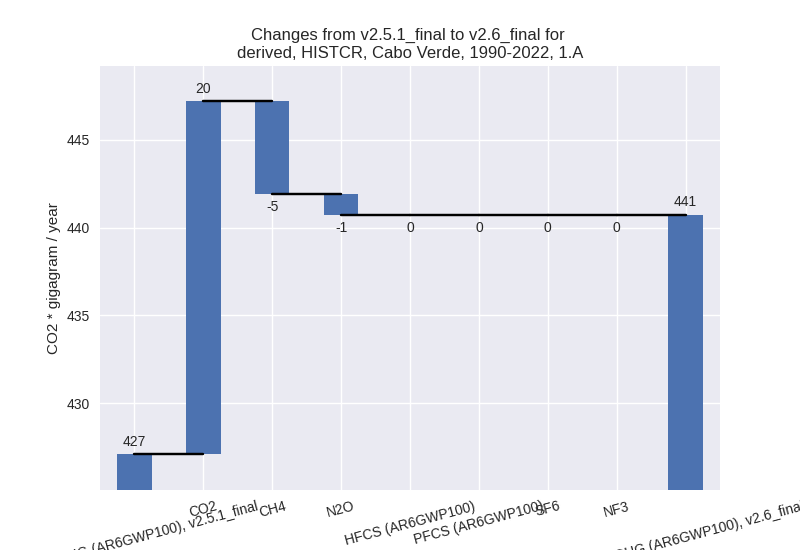
There is no subsector information available in PRIMAP-hist. - 1.B.1: Total sectoral emissions in 2022 are 0.99 Gg
CO2 / year which is 0.1% of category 1 emissions. 2022 Emissions have
changed by inf% (0.99 Gg CO2 /
year). 1990-2022 Emissions have changed by inf% (7.62 Gg CO2 / year). For 2022 the
changes per gas
are:
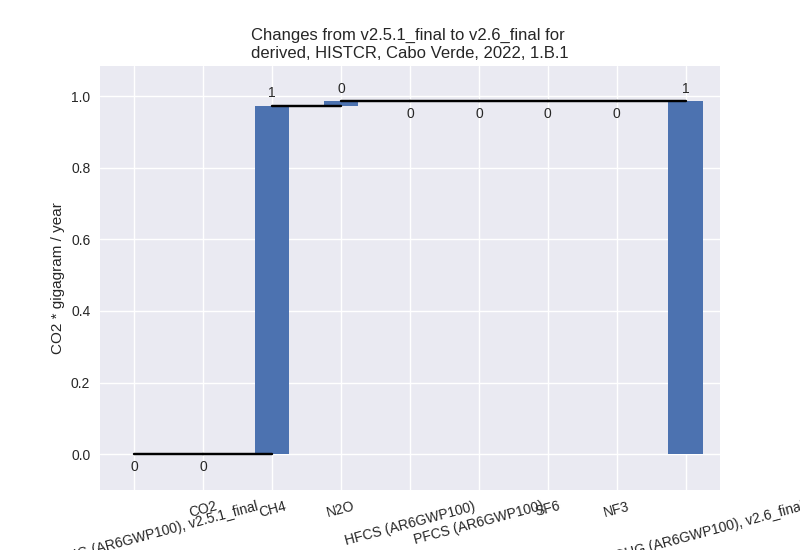
For 1990-2022 the changes per gas are: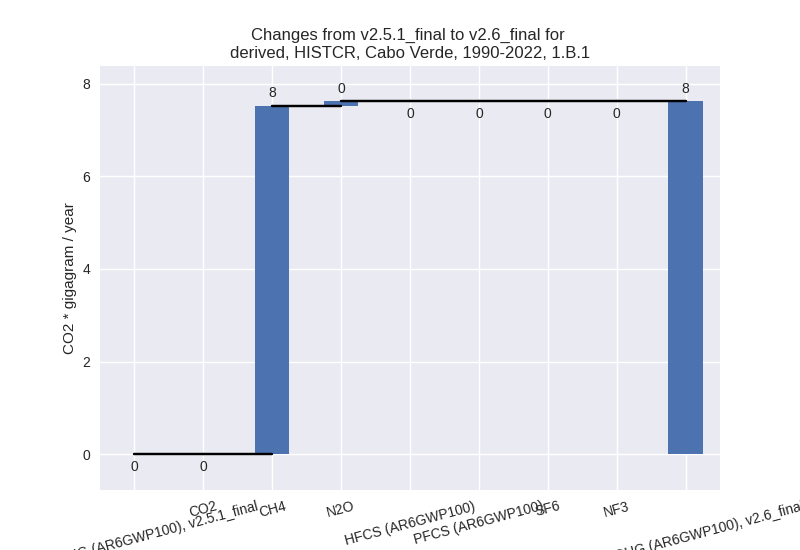
There is no subsector information available in PRIMAP-hist. - 1.B.2: Total sectoral emissions in 2022 are 0.00 Gg CO2 / year which is 0.0% of category 1 emissions. 2022 Emissions have changed by 0.4% (0.00 Gg CO2 / year). 1990-2022 Emissions have changed by 0.1% (0.00 Gg CO2 / year).
- 1.A: Total sectoral emissions in 2022 are 830.14 Gg
CO2 / year which is 99.9% of category 1 emissions. 2022 Emissions have
changed by 29.2% (187.79 Gg CO2 /
year). 1990-2022 Emissions have changed by 3.2% (13.64 Gg CO2 / year). For 2022 the
changes per gas
are:
- 2: Total sectoral emissions in 2022 are 48.52 Gg
CO2 / year which is 4.0% of M.0.EL emissions. 2022 Emissions have
changed by 498.6% (40.41 Gg CO2 /
year). 1990-2022 Emissions have changed by 276.0% (7.97 Gg CO2 / year). For 2022 the
changes per gas
are:
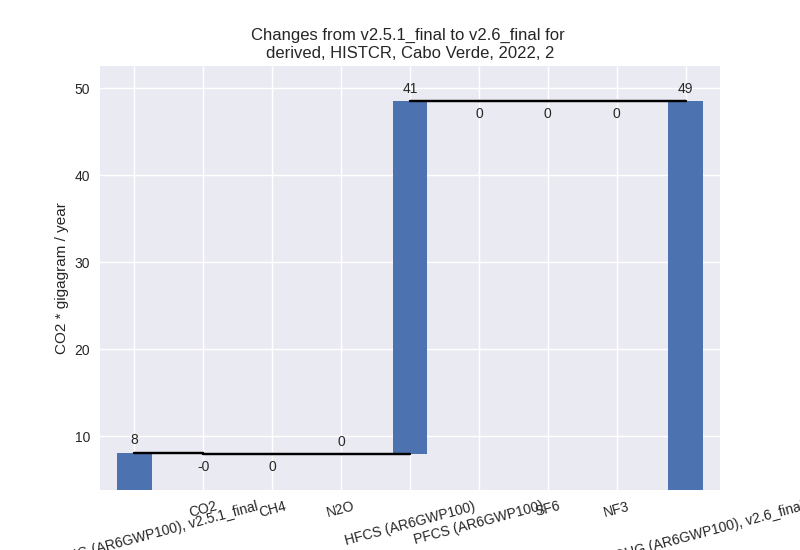
For 1990-2022 the changes per gas are: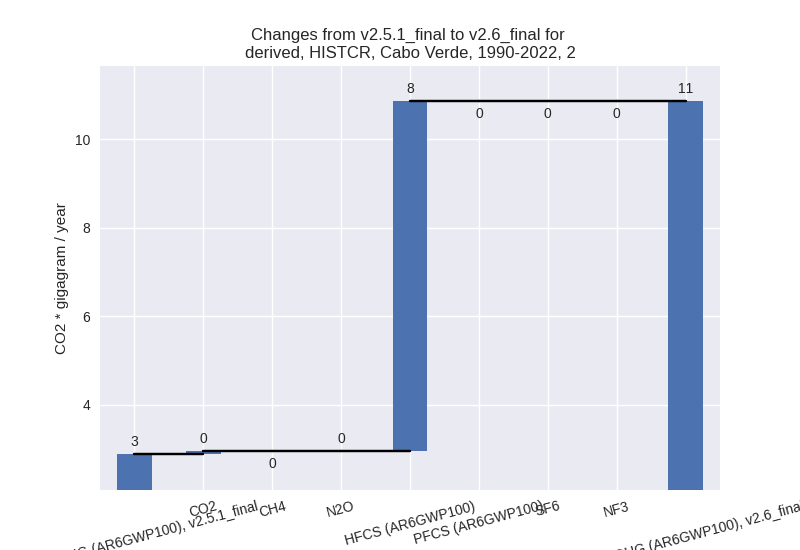
- M.AG: Total sectoral emissions in 2022 are 126.30
Gg CO2 / year which is 10.4% of M.0.EL emissions. 2022 Emissions have
changed by -3.8% (-4.99 Gg CO2 /
year). 1990-2022 Emissions have changed by -2.5% (-3.05 Gg CO2 / year). For 2022 the
changes per gas
are:
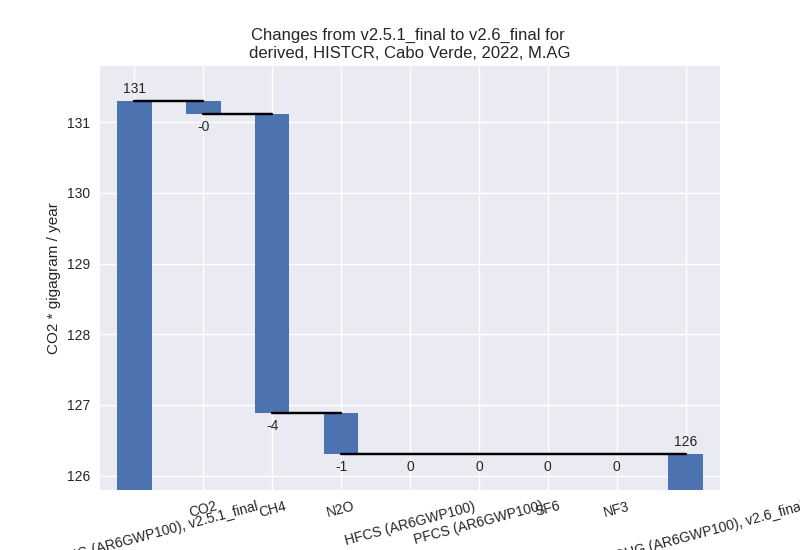
For 1990-2022 the changes per gas are: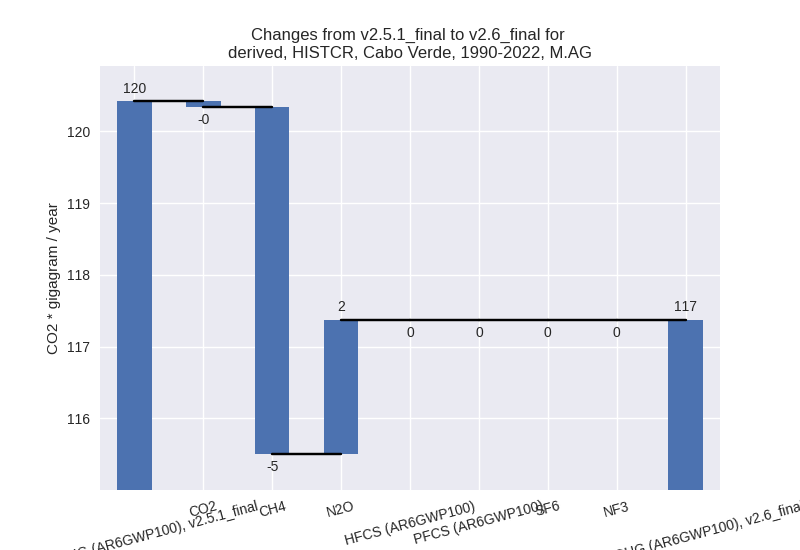
The changes come from the following subsectors:- 3.A: Total sectoral emissions in 2022 are 82.51 Gg
CO2 / year which is 65.3% of category M.AG emissions. 2022 Emissions
have changed by 30.1% (19.07 Gg CO2
/ year). 1990-2022 Emissions have changed by 33.7% (18.59 Gg CO2 / year). For 2022 the
changes per gas
are:
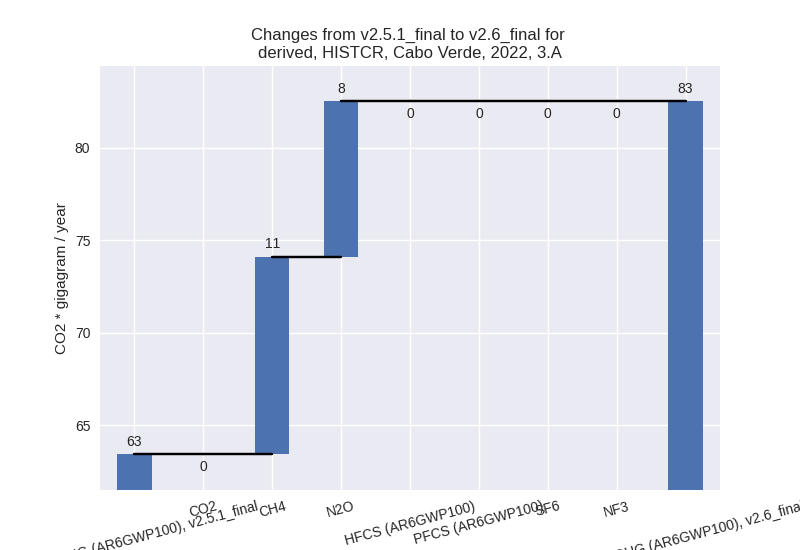
For 1990-2022 the changes per gas are:
There is no subsector information available in PRIMAP-hist. - M.AG.ELV: Total sectoral emissions in 2022 are
43.80 Gg CO2 / year which is 34.7% of category M.AG emissions. 2022
Emissions have changed by -35.5%
(-24.06 Gg CO2 / year). 1990-2022 Emissions have changed by -33.2% (-21.64 Gg CO2 / year). For 2022
the changes per gas
are:
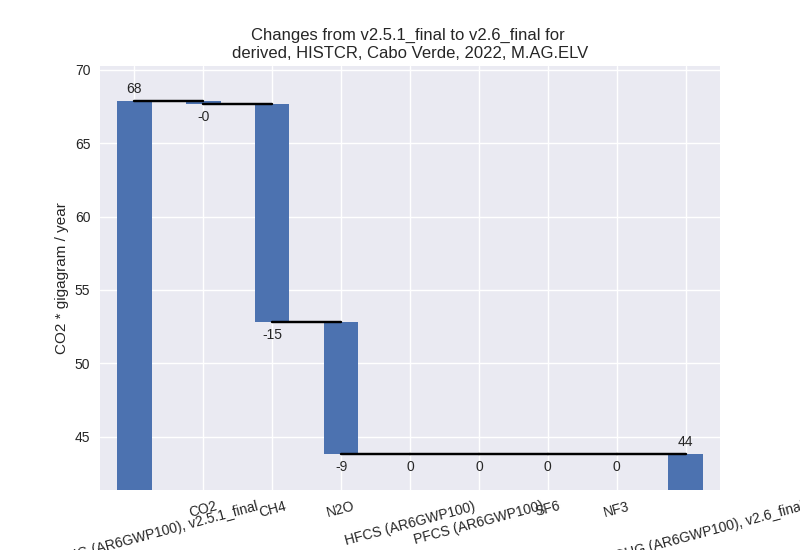
For 1990-2022 the changes per gas are: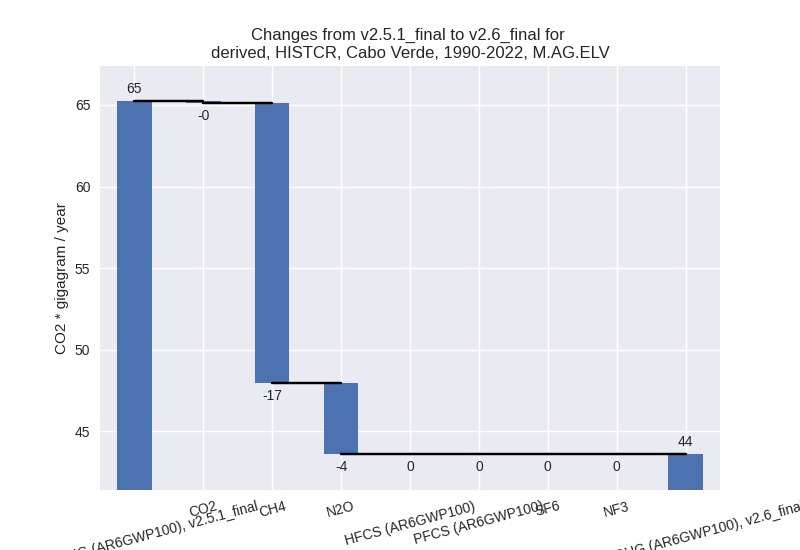
There is no subsector information available in PRIMAP-hist.
- 3.A: Total sectoral emissions in 2022 are 82.51 Gg
CO2 / year which is 65.3% of category M.AG emissions. 2022 Emissions
have changed by 30.1% (19.07 Gg CO2
/ year). 1990-2022 Emissions have changed by 33.7% (18.59 Gg CO2 / year). For 2022 the
changes per gas
are:
- 4: Total sectoral emissions in 2022 are 198.37 Gg
CO2 / year which is 16.3% of M.0.EL emissions. 2022 Emissions have
changed by 123.6% (109.65 Gg CO2 /
year). 1990-2022 Emissions have changed by 136.4% (75.09 Gg CO2 / year). For 2022 the
changes per gas
are:
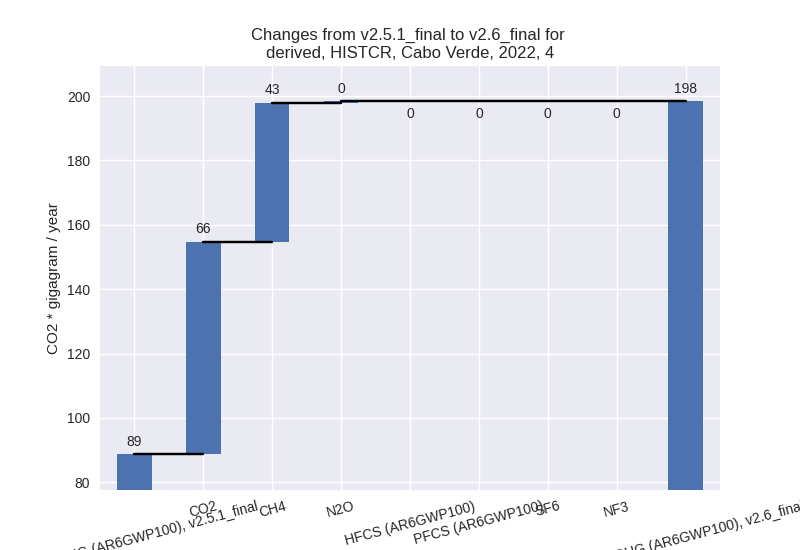
For 1990-2022 the changes per gas are: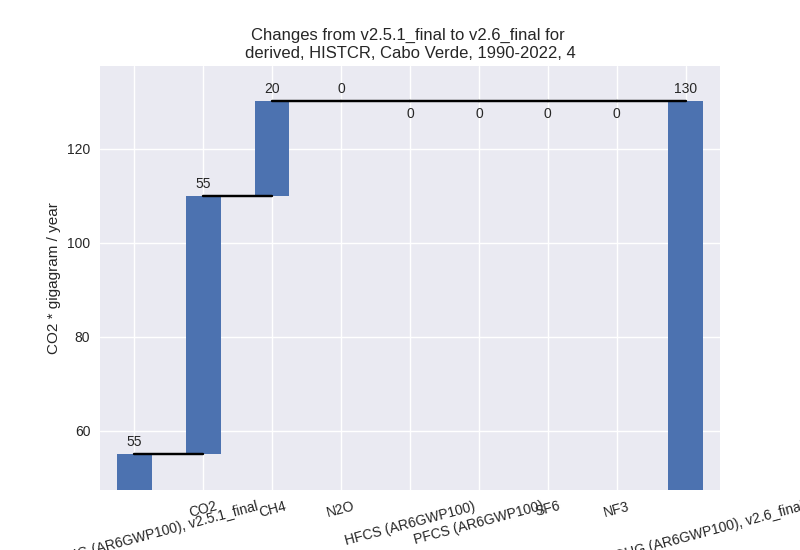
- 5: Total sectoral emissions in 2022 are 13.35 Gg
CO2 / year which is 1.1% of M.0.EL emissions. 2022 Emissions have
changed by inf% (13.35 Gg CO2 /
year). 1990-2022 Emissions have changed by inf% (7.42 Gg CO2 / year). For 2022 the
changes per gas
are:
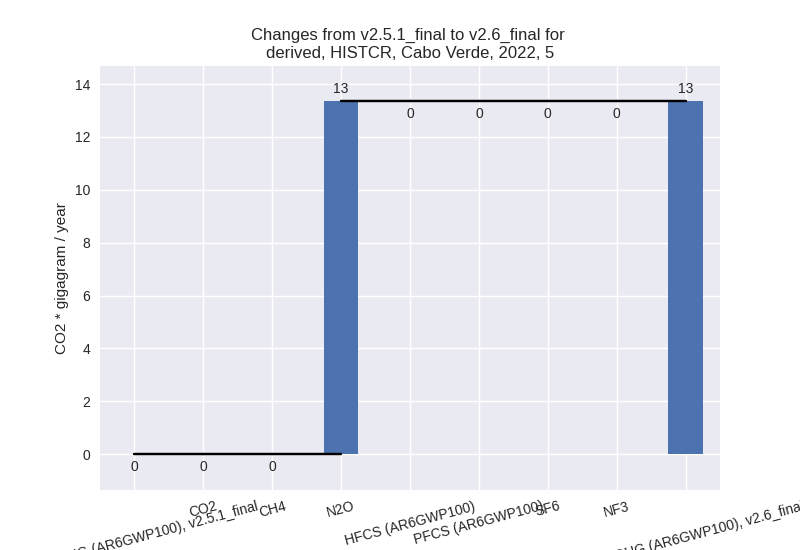
For 1990-2022 the changes per gas are: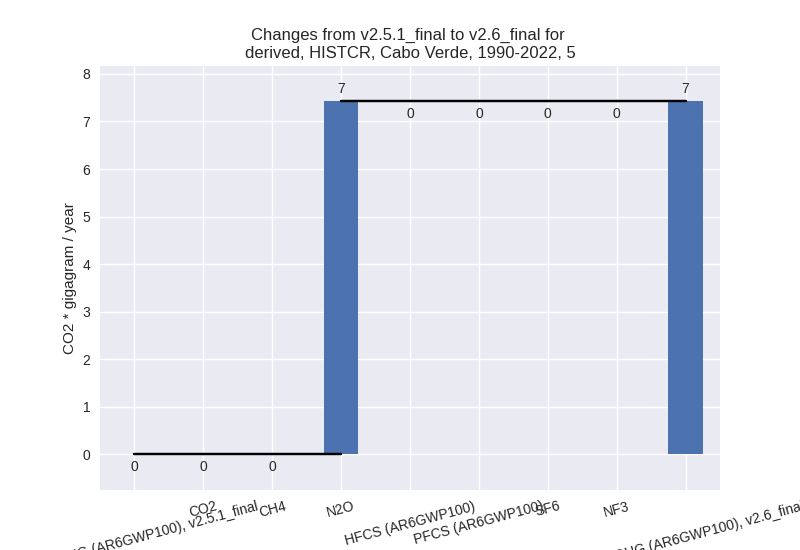
third party scenario (HISTTP):
Most important changes per time frame
For 2022 the following sector-gas combinations have the highest absolute impact on national total KyotoGHG (AR6GWP100) emissions in 2022 (top 5):
- 1: 4, CO2 with 66.03 Gg CO2 / year (15133.1%)
- 2: 1.A, CO2 with 46.91 Gg CO2 / year (7.1%)
- 3: 2, HFCS (AR6GWP100) with 40.58 Gg CO2 / year (594.7%)
- 4: 5, N2O with -1.99 Gg CO2 / year (-13.0%)
- 5: 4, CH4 with 0.35 Gg CO2 / year (0.3%)
For 1990-2022 the following sector-gas combinations have the highest absolute impact on national total KyotoGHG (AR6GWP100) emissions in 1990-2022 (top 5):
- 1: 4, CO2 with 54.89 Gg CO2 / year (23824.3%)
- 2: 2, HFCS (AR6GWP100) with 7.90 Gg CO2 / year (360.8%)
- 3: 1.A, CO2 with 3.12 Gg CO2 / year (0.8%)
- 4: 5, N2O with -0.37 Gg CO2 / year (-4.7%)
- 5: 4, CH4 with -0.12 Gg CO2 / year (-0.1%)
Changes in the main sectors for aggregate KyotoGHG (AR6GWP100) are
- 1: Total sectoral emissions in 2022 are 746.83 Gg
CO2 / year which is 67.0% of M.0.EL emissions. 2022 Emissions have
changed by 6.7% (46.91 Gg CO2 /
year). 1990-2022 Emissions have changed by 0.7% (3.12 Gg CO2 / year). For 2022 the
changes per gas
are:
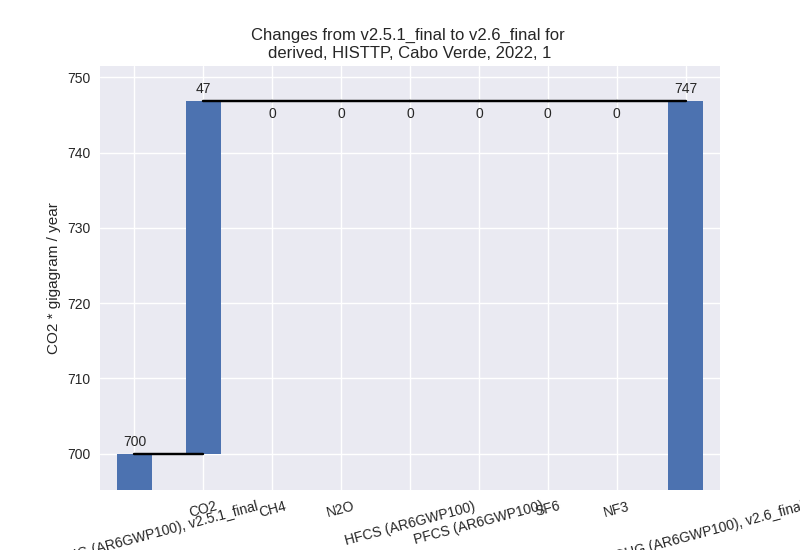
The changes come from the following subsectors:- 1.A: Total sectoral emissions in 2022 are 745.84 Gg
CO2 / year which is 99.9% of category 1 emissions. 2022 Emissions have
changed by 6.7% (46.91 Gg CO2 /
year). 1990-2022 Emissions have changed by 0.7% (3.12 Gg CO2 / year). For 2022 the
changes per gas
are:
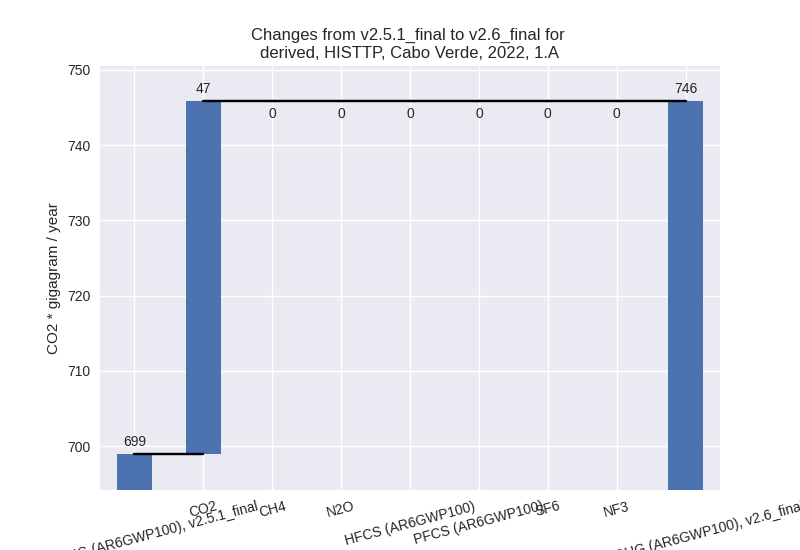
There is no subsector information available in PRIMAP-hist. - 1.B.1: Total sectoral emissions in 2022 are 0.99 Gg CO2 / year which is 0.1% of category 1 emissions. 2022 Emissions have changed by 0.0% (0.00 Gg CO2 / year). 1990-2022 Emissions have changed by 0.0% (0.00 Gg CO2 / year).
- 1.B.2: Total sectoral emissions in 2022 are 0.00 Gg CO2 / year which is 0.0% of category 1 emissions. 2022 Emissions have changed by 0.4% (0.00 Gg CO2 / year). 1990-2022 Emissions have changed by 0.1% (0.00 Gg CO2 / year).
- 1.A: Total sectoral emissions in 2022 are 745.84 Gg
CO2 / year which is 99.9% of category 1 emissions. 2022 Emissions have
changed by 6.7% (46.91 Gg CO2 /
year). 1990-2022 Emissions have changed by 0.7% (3.12 Gg CO2 / year). For 2022 the
changes per gas
are:
- 2: Total sectoral emissions in 2022 are 51.11 Gg
CO2 / year which is 4.6% of M.0.EL emissions. 2022 Emissions have
changed by 385.5% (40.58 Gg CO2 /
year). 1990-2022 Emissions have changed by 182.7% (7.90 Gg CO2 / year). For 2022 the
changes per gas
are:
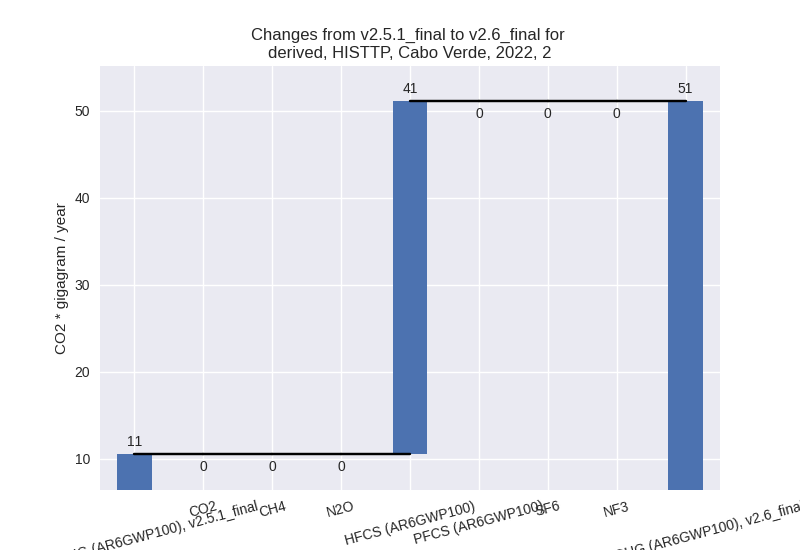
For 1990-2022 the changes per gas are: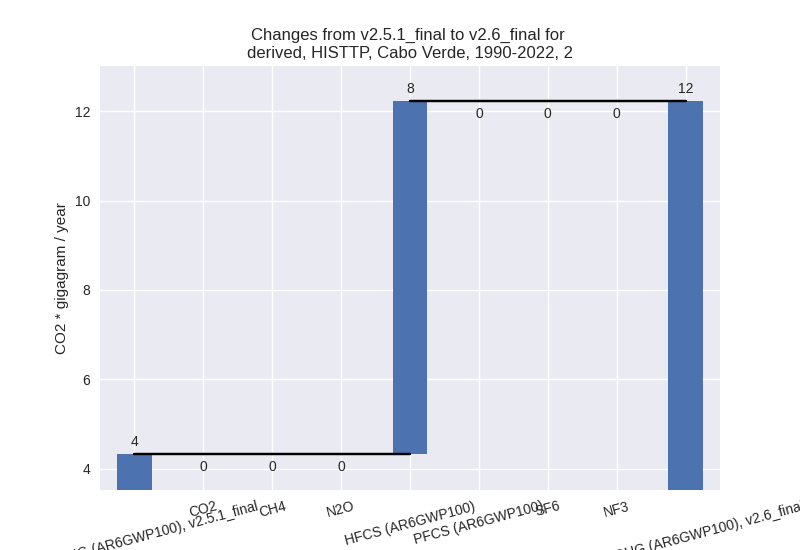
- M.AG: Total sectoral emissions in 2022 are 114.21 Gg CO2 / year which is 10.2% of M.0.EL emissions. 2022 Emissions have changed by -0.2% (-0.19 Gg CO2 / year). 1990-2022 Emissions have changed by -0.1% (-0.08 Gg CO2 / year).
- 4: Total sectoral emissions in 2022 are 188.81 Gg
CO2 / year which is 16.9% of M.0.EL emissions. 2022 Emissions have
changed by 54.1% (66.26 Gg CO2 /
year). 1990-2022 Emissions have changed by 60.3% (54.78 Gg CO2 / year). For 2022 the
changes per gas
are:
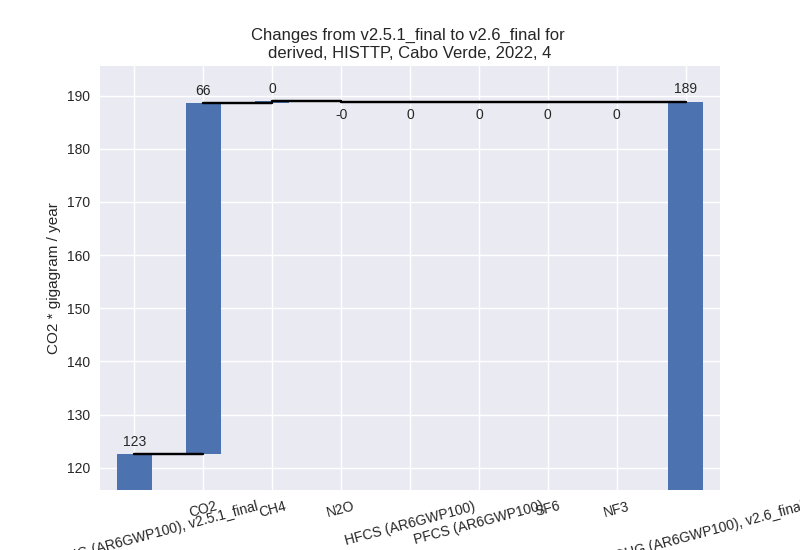
For 1990-2022 the changes per gas are: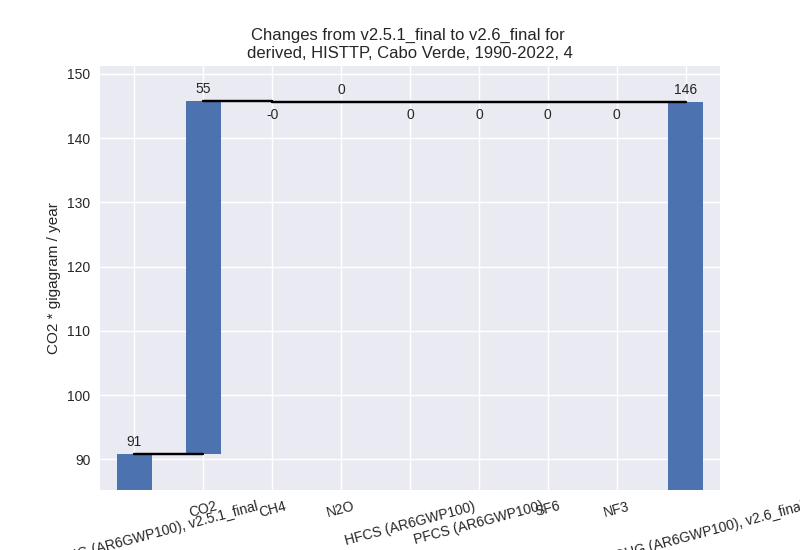
- 5: Total sectoral emissions in 2022 are 13.35 Gg
CO2 / year which is 1.2% of M.0.EL emissions. 2022 Emissions have
changed by -13.0% (-1.99 Gg CO2 /
year). 1990-2022 Emissions have changed by -4.7% (-0.37 Gg CO2 / year). For 2022 the
changes per gas
are:
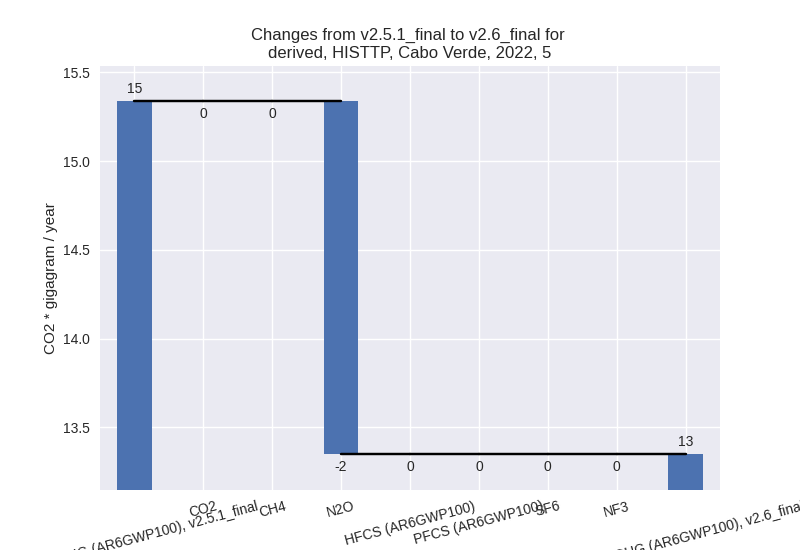
For 1990-2022 the changes per gas are: